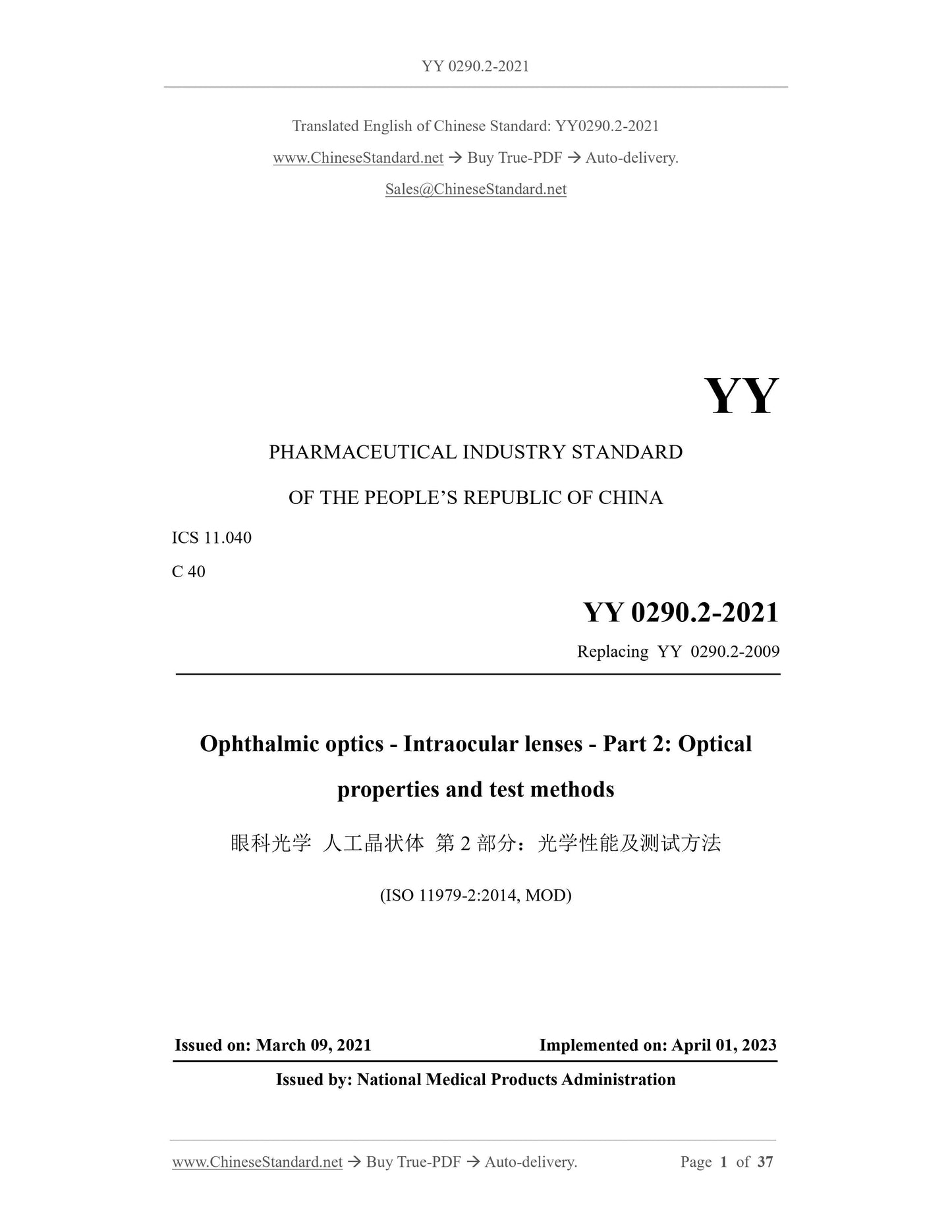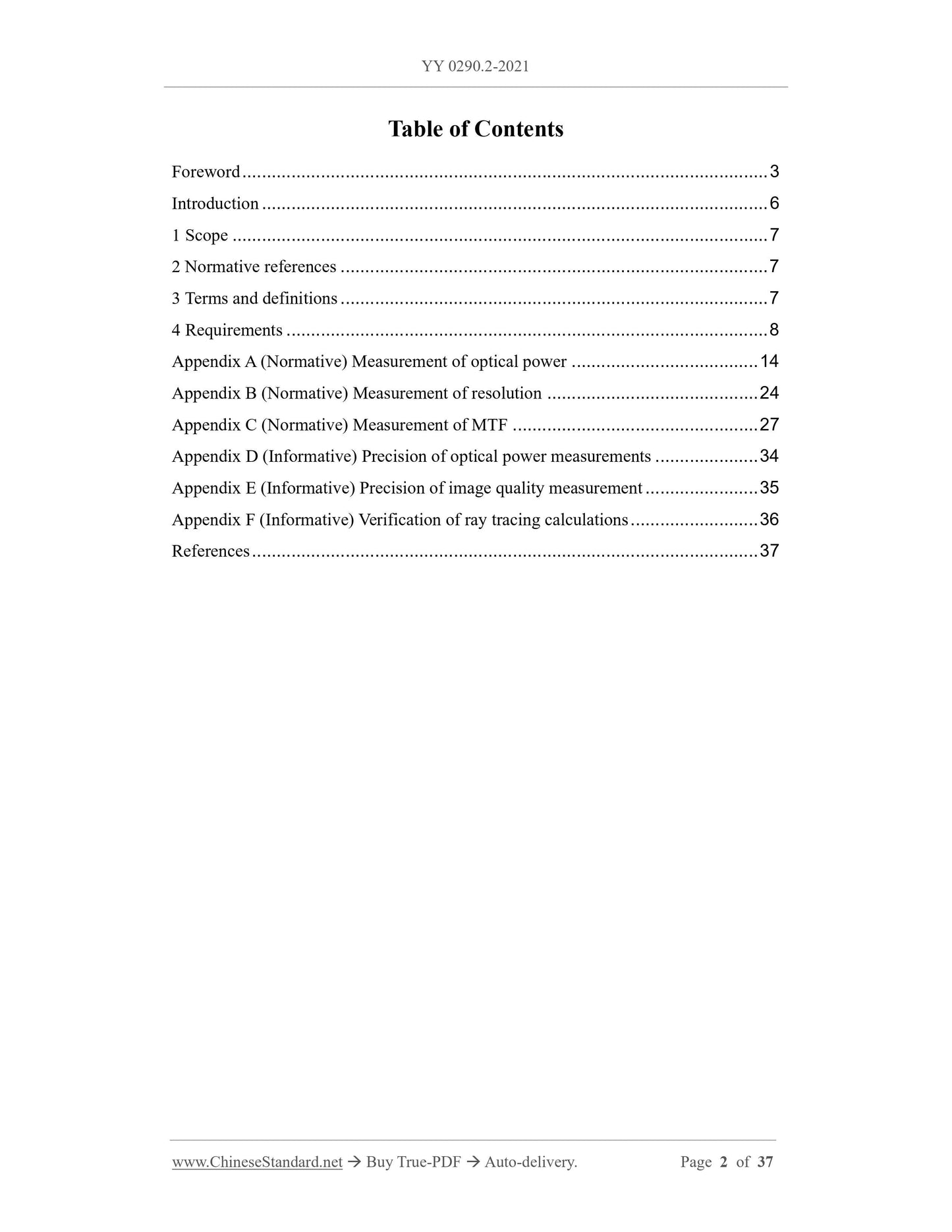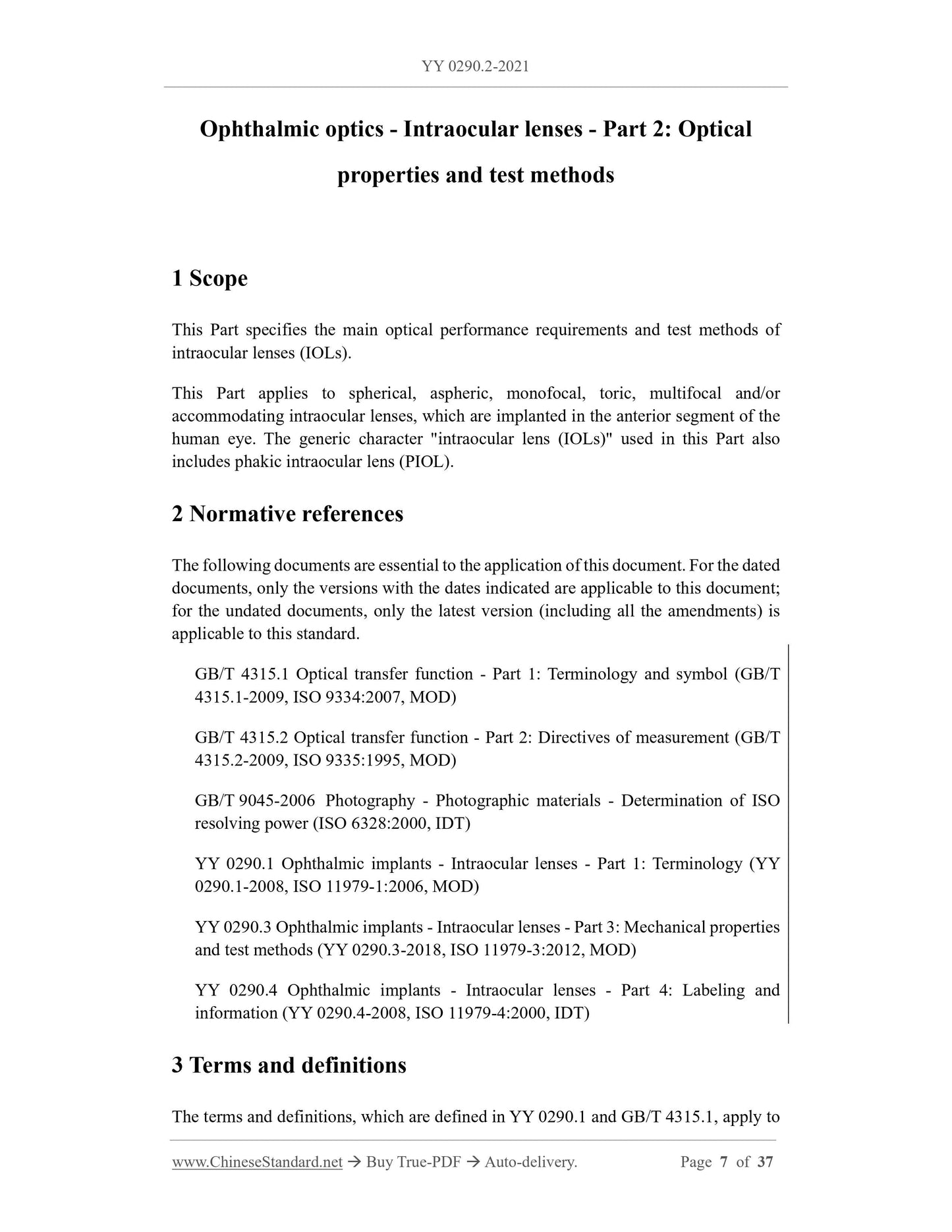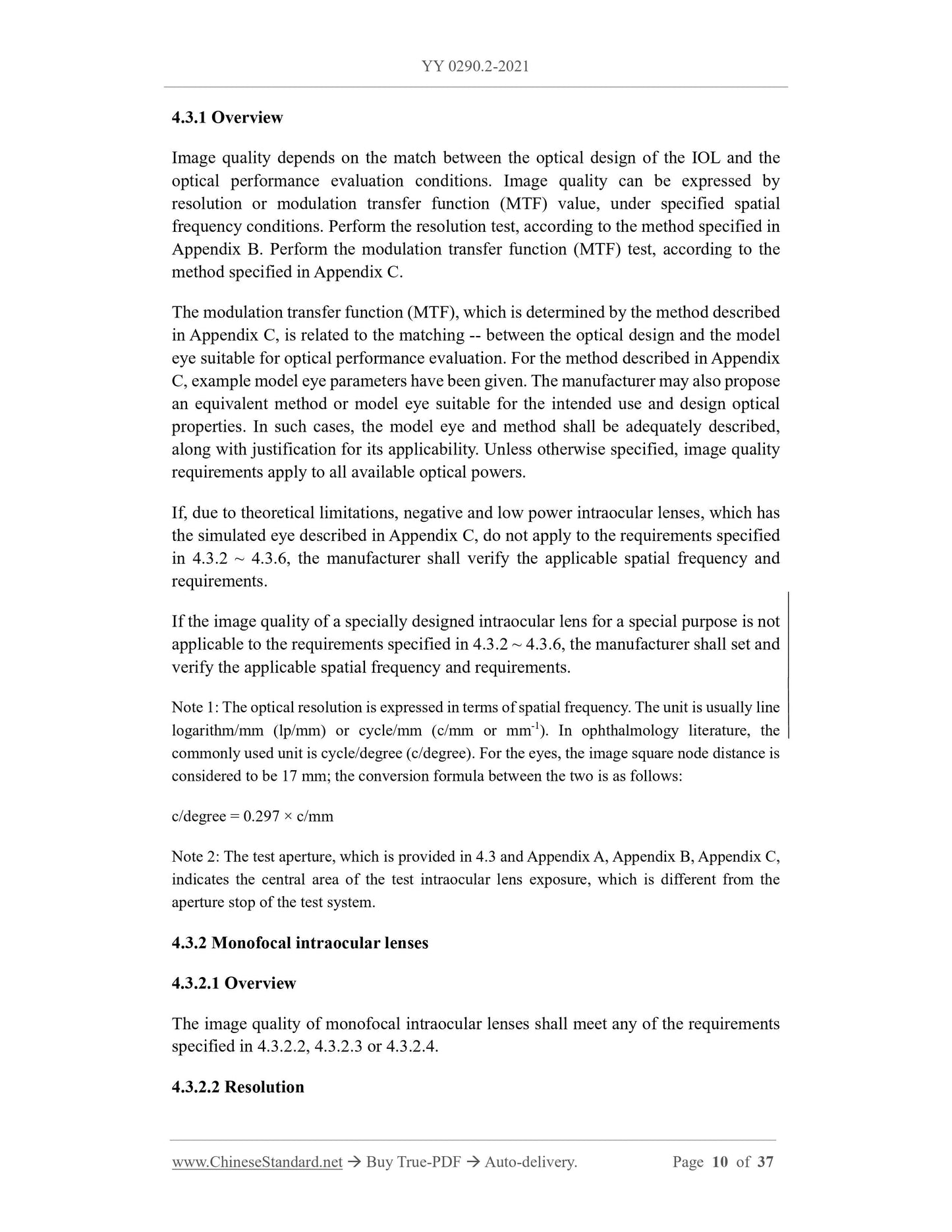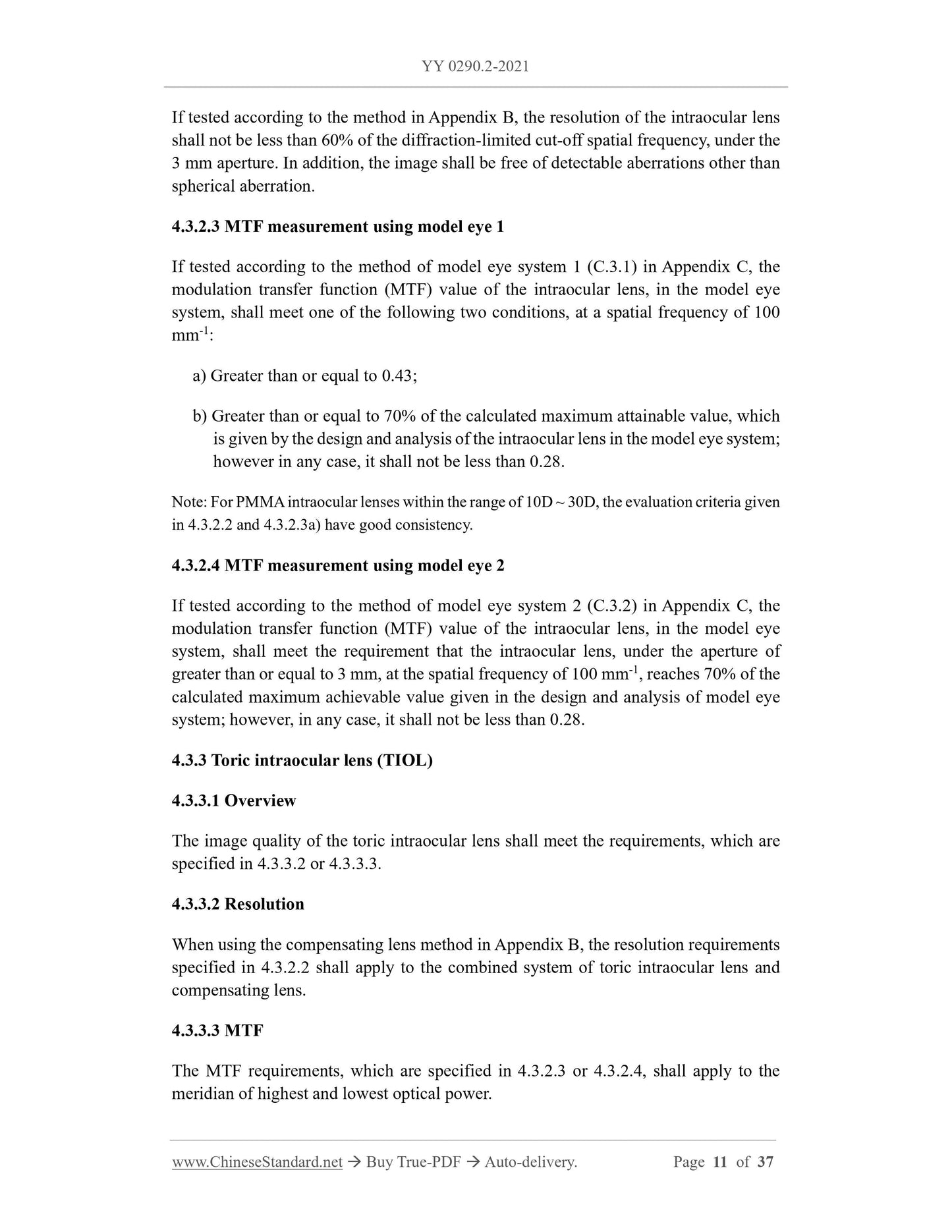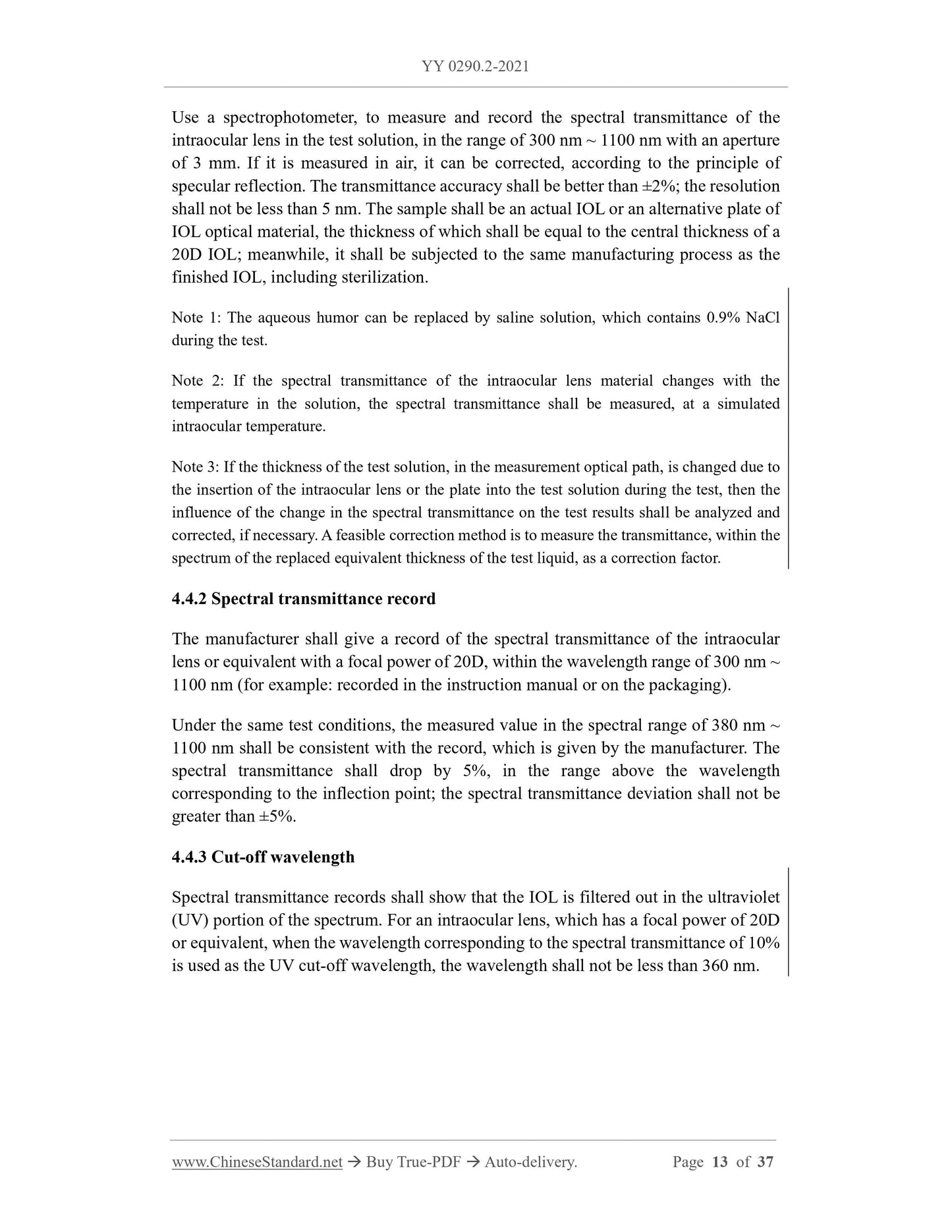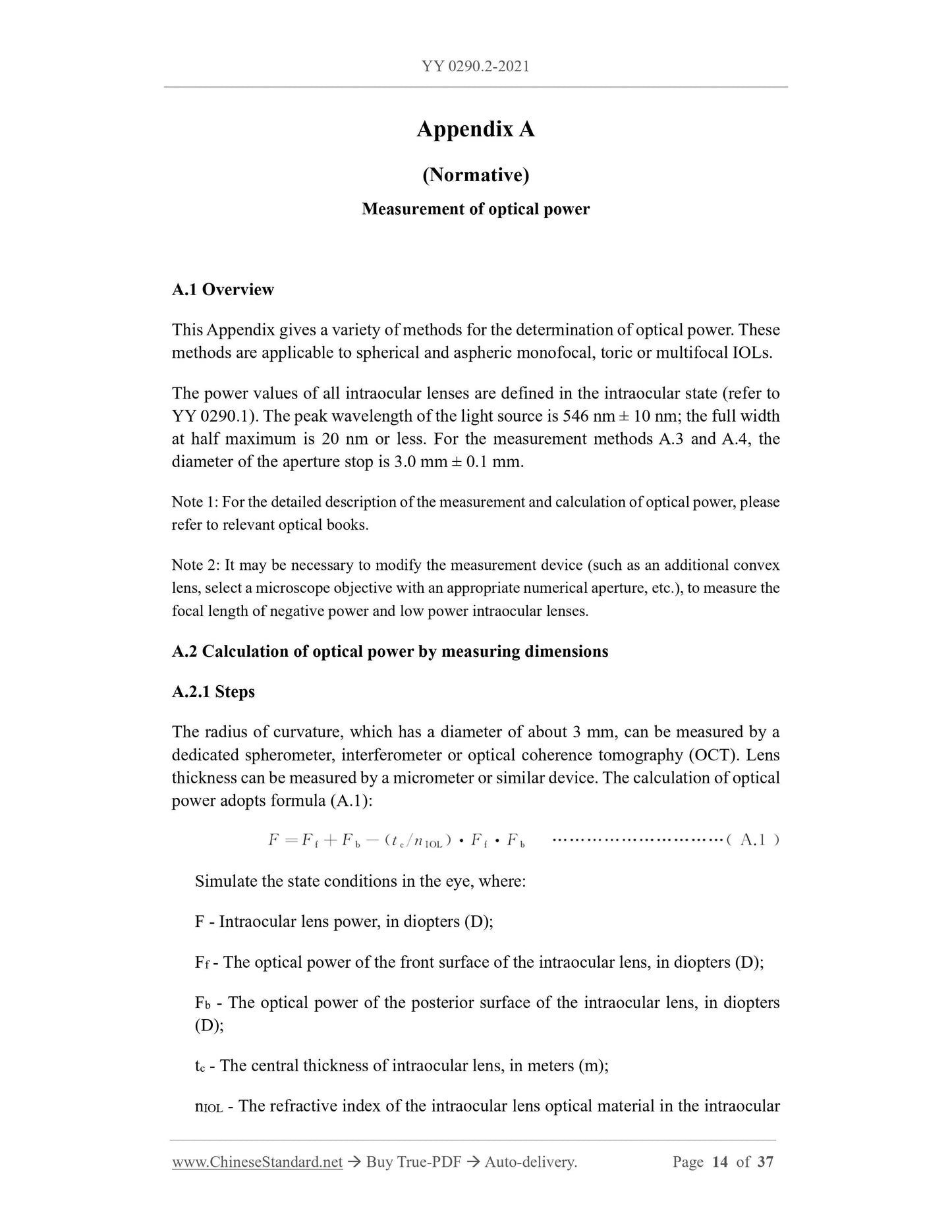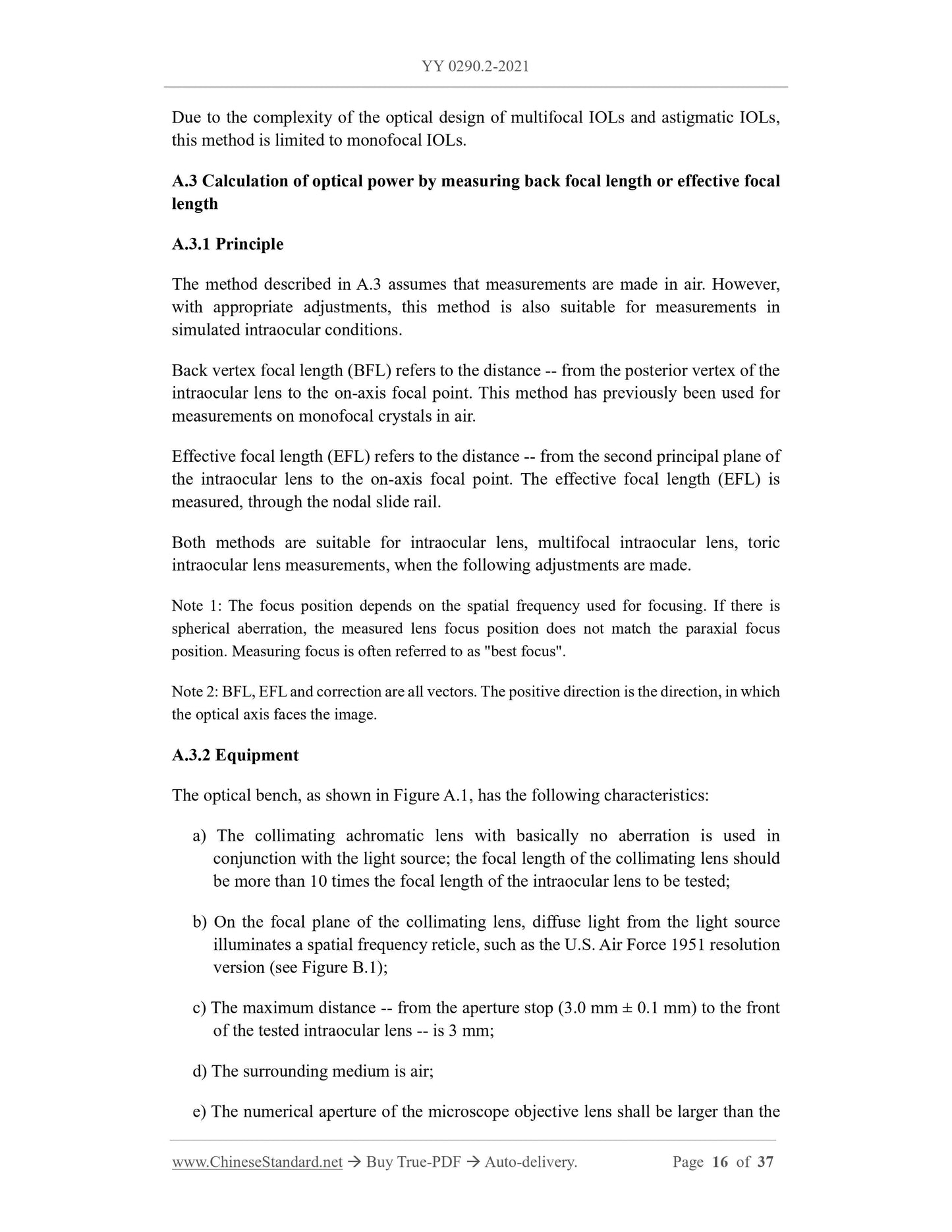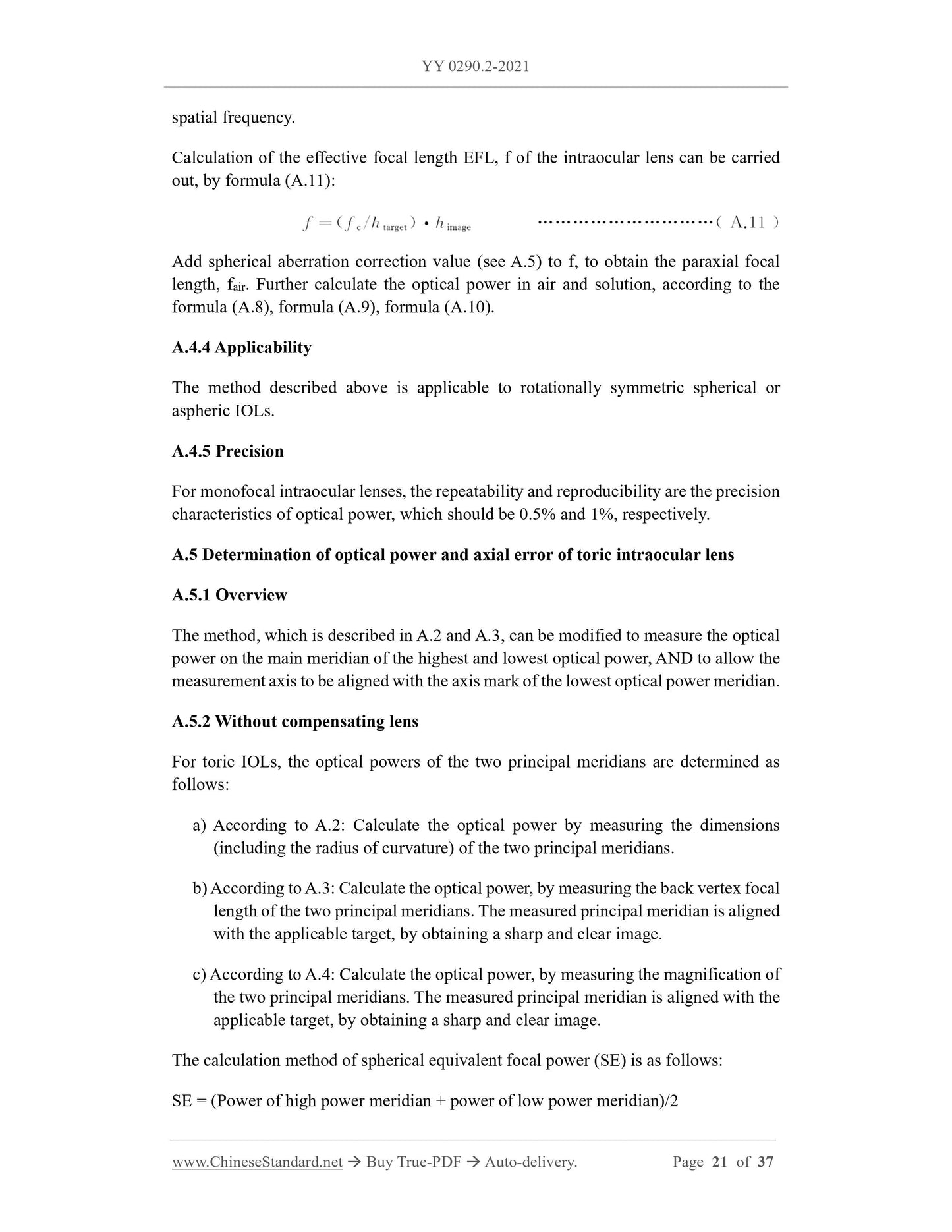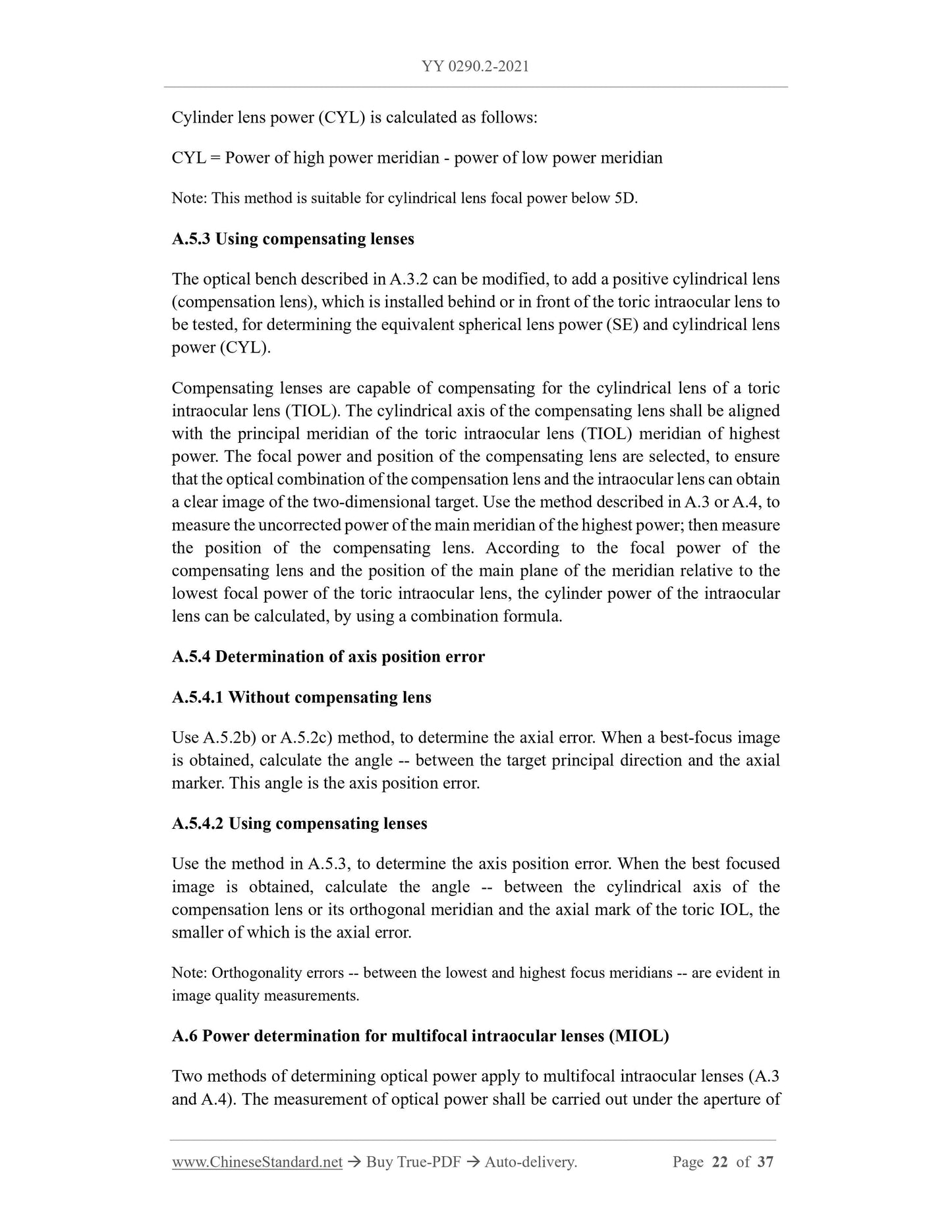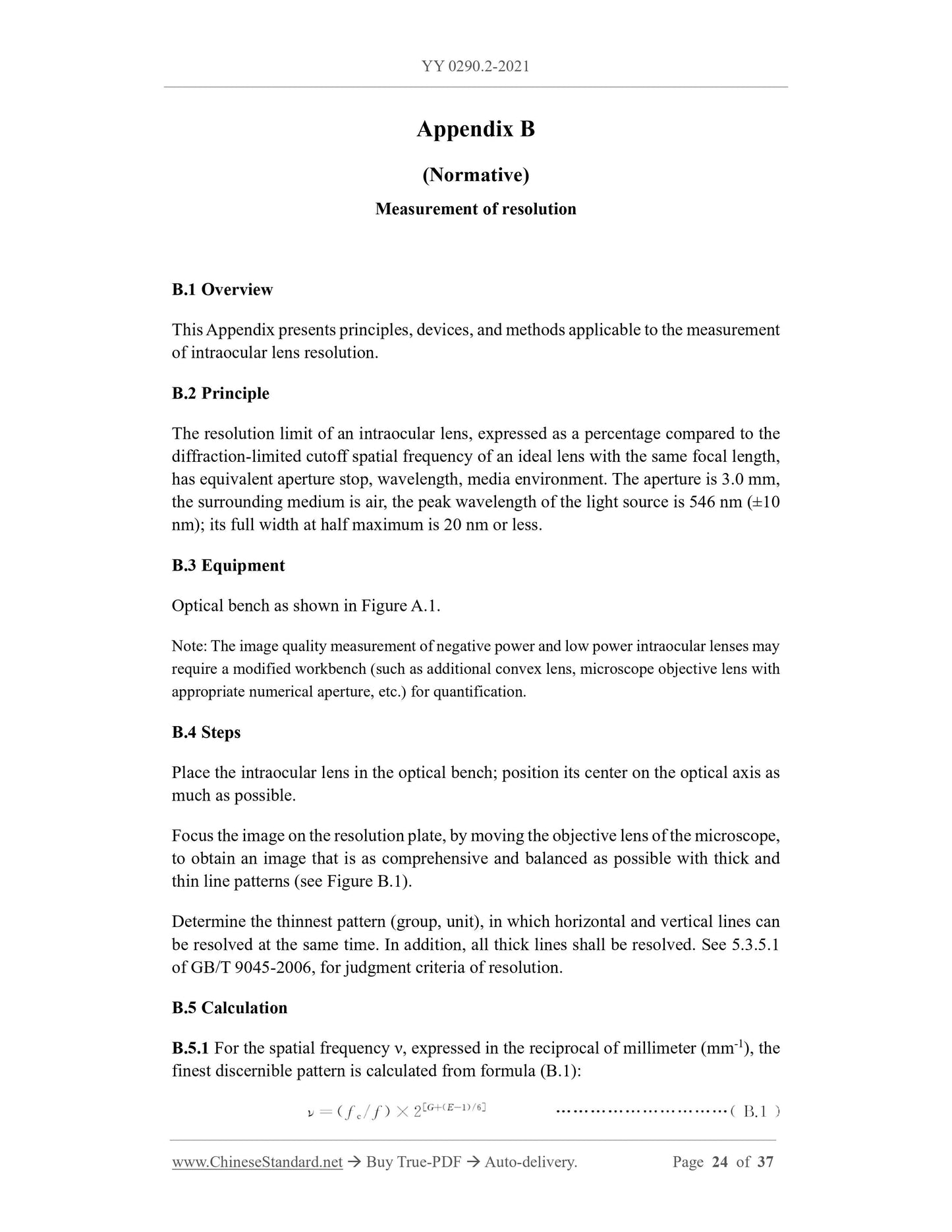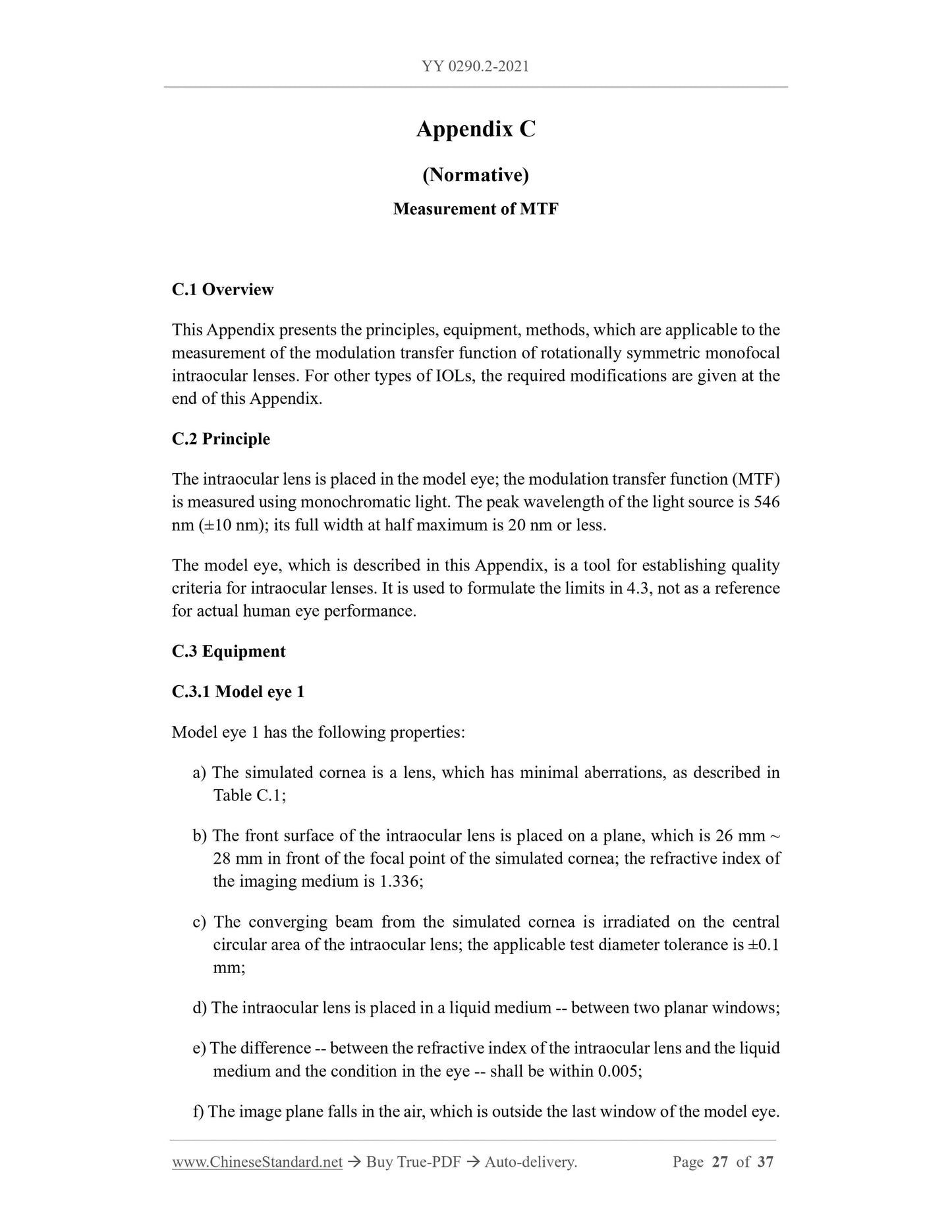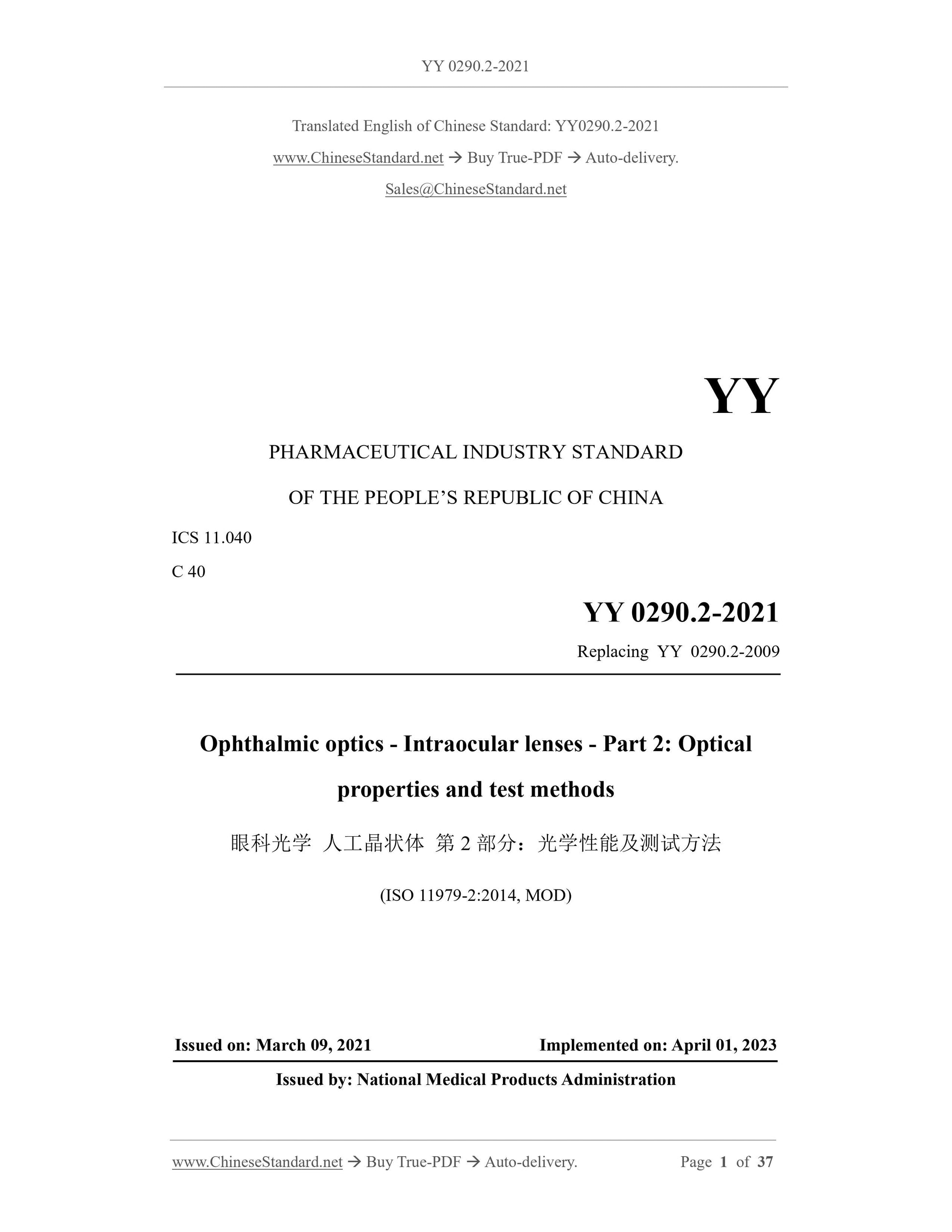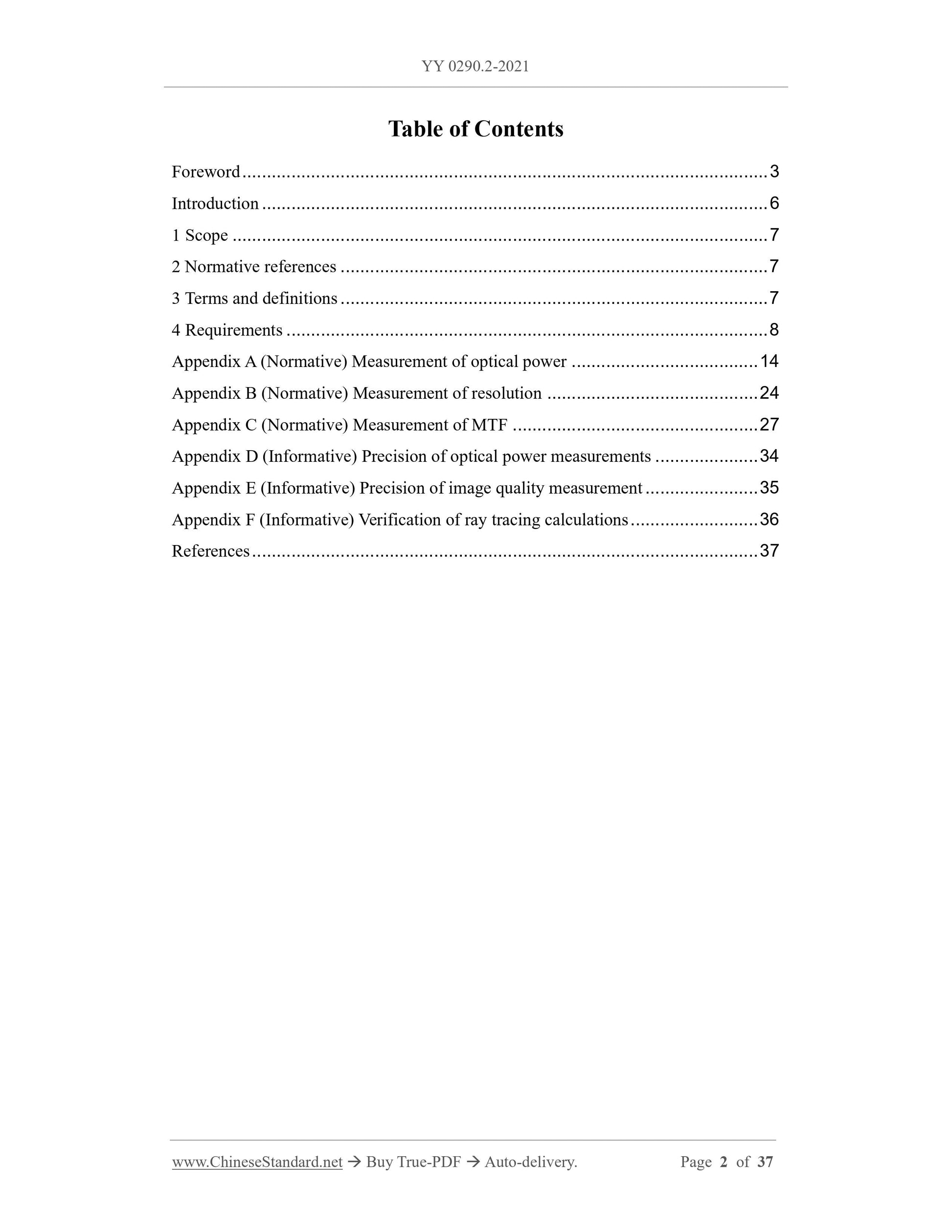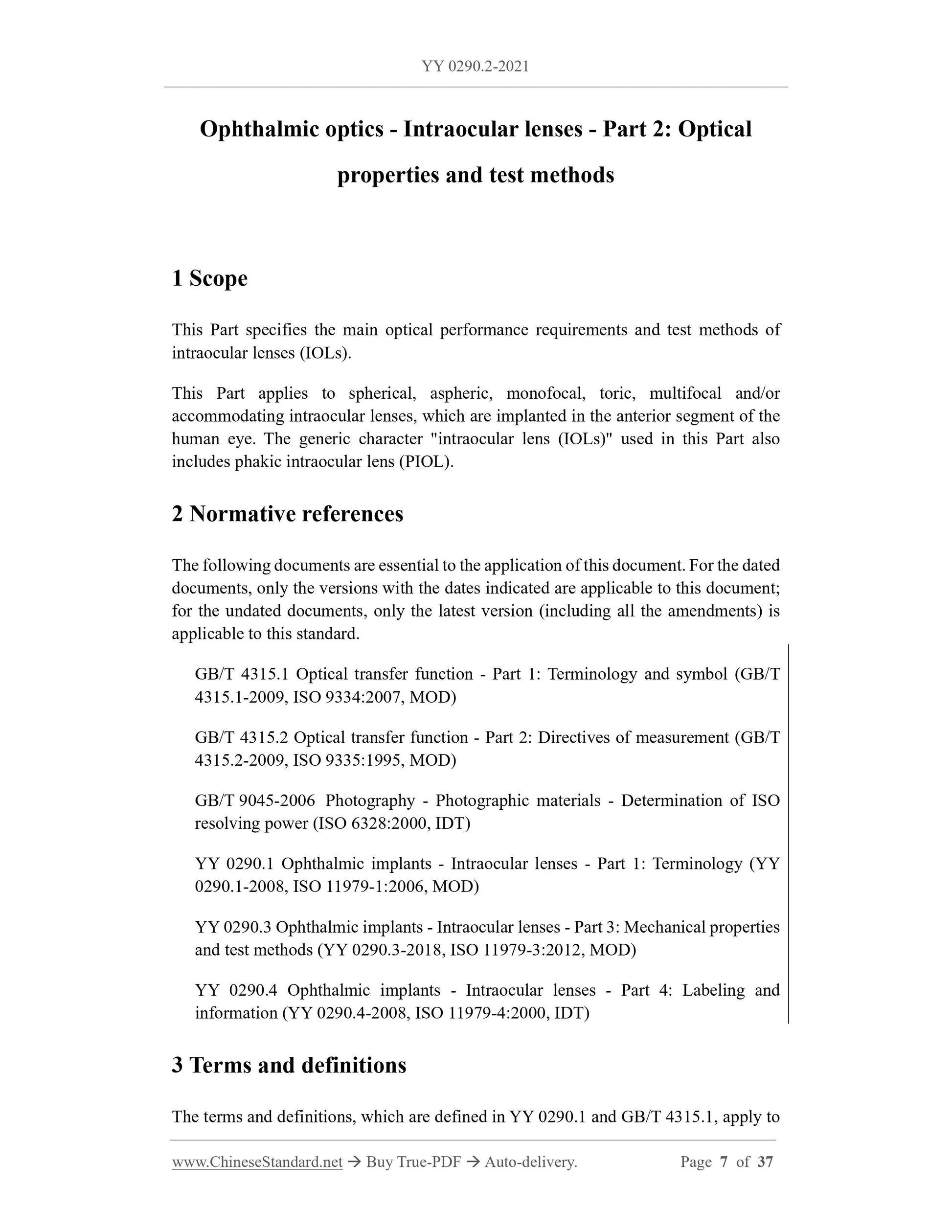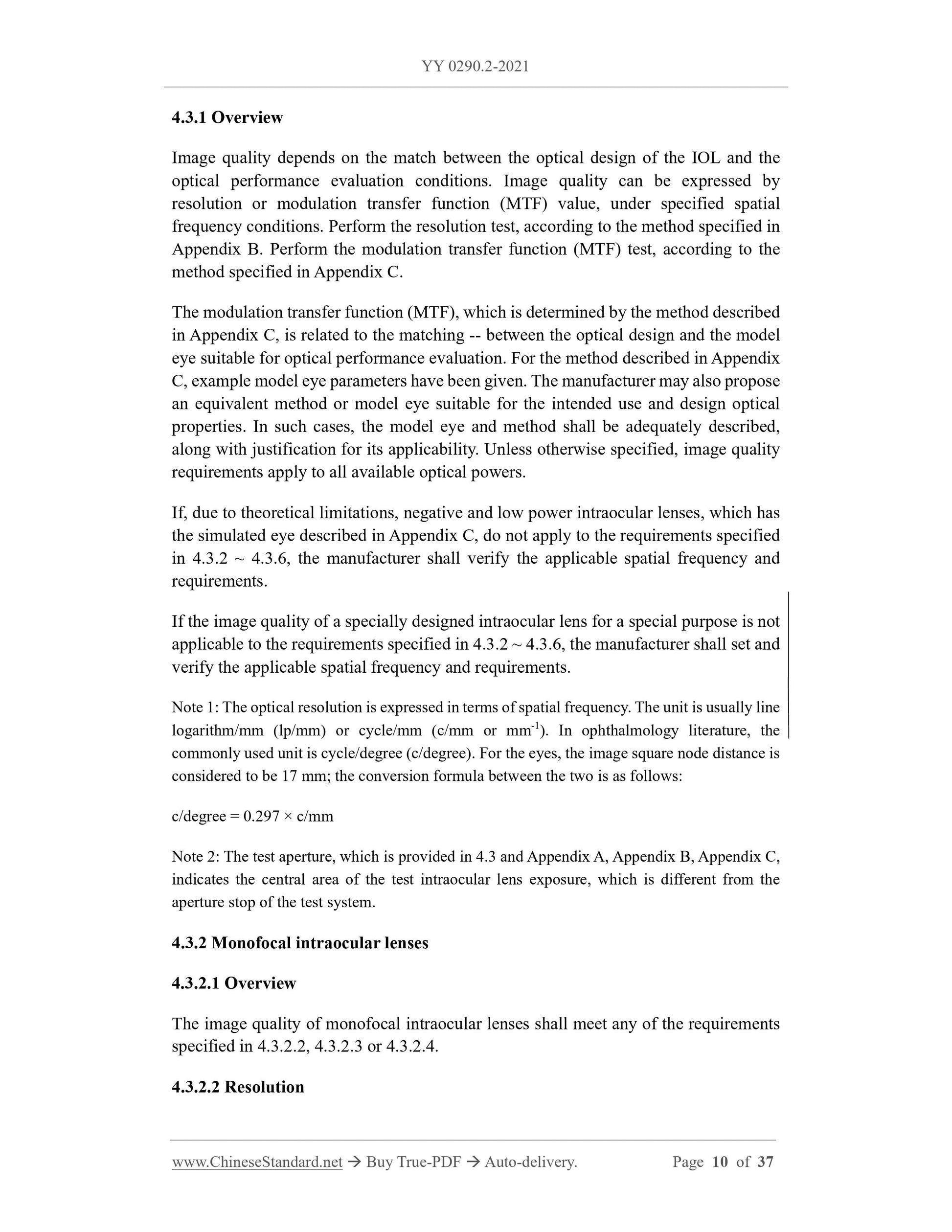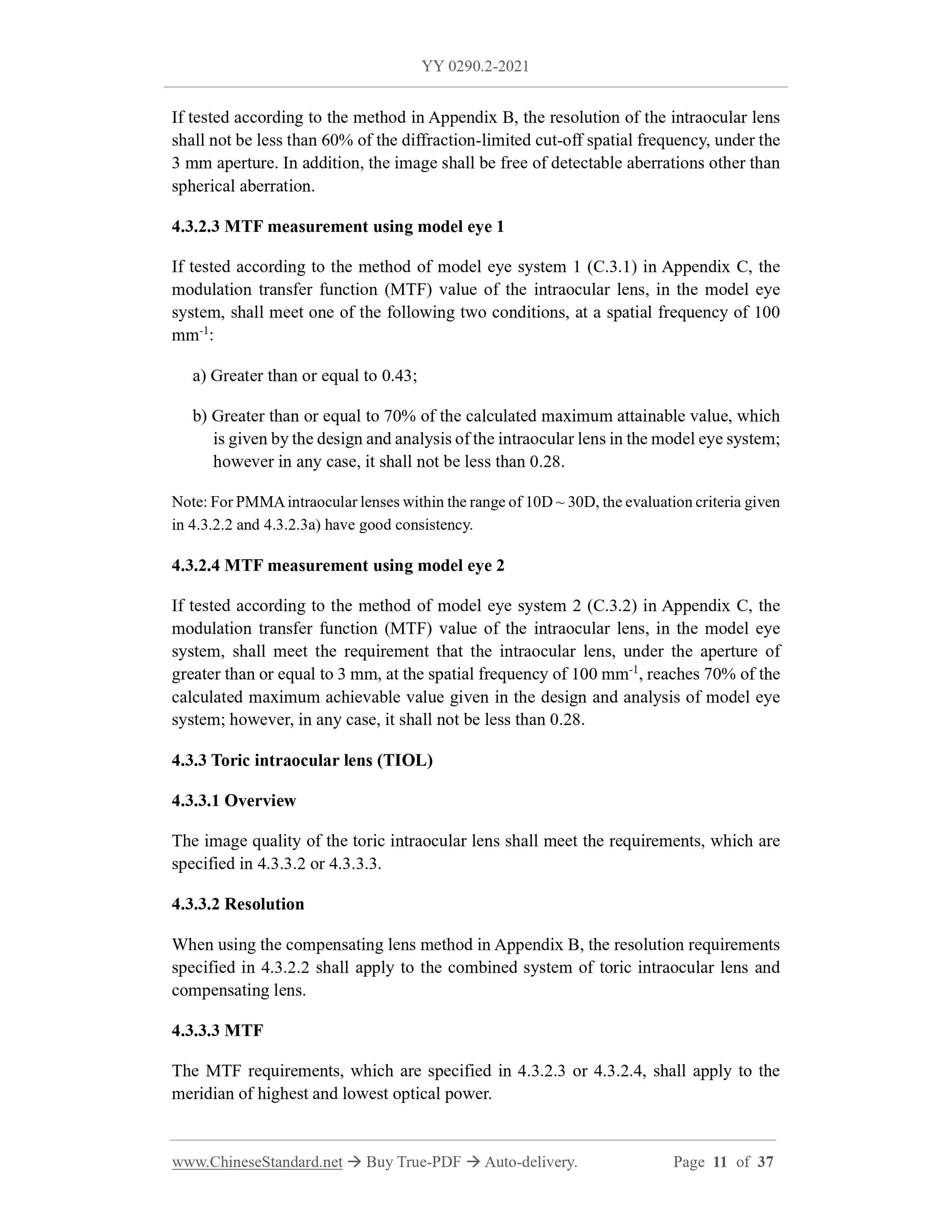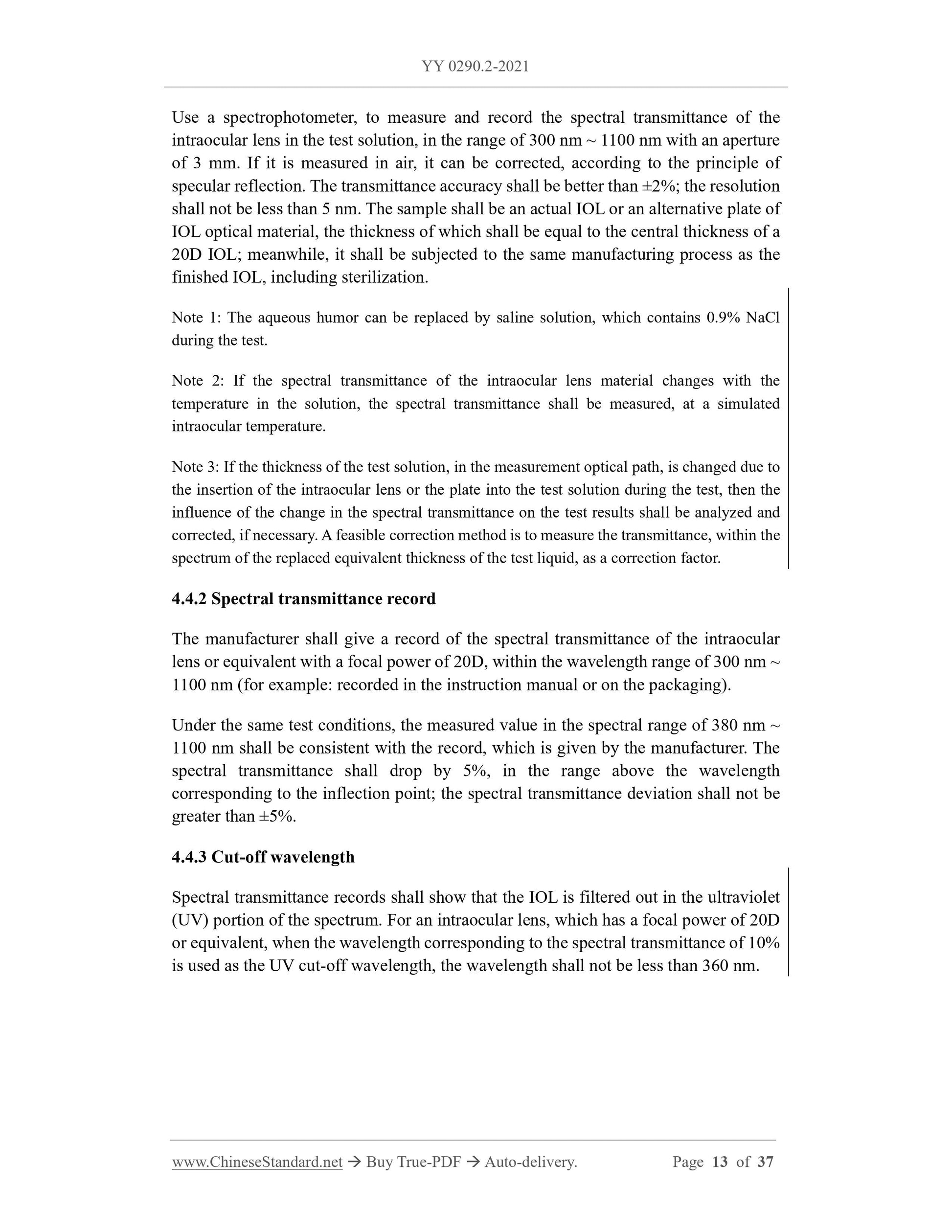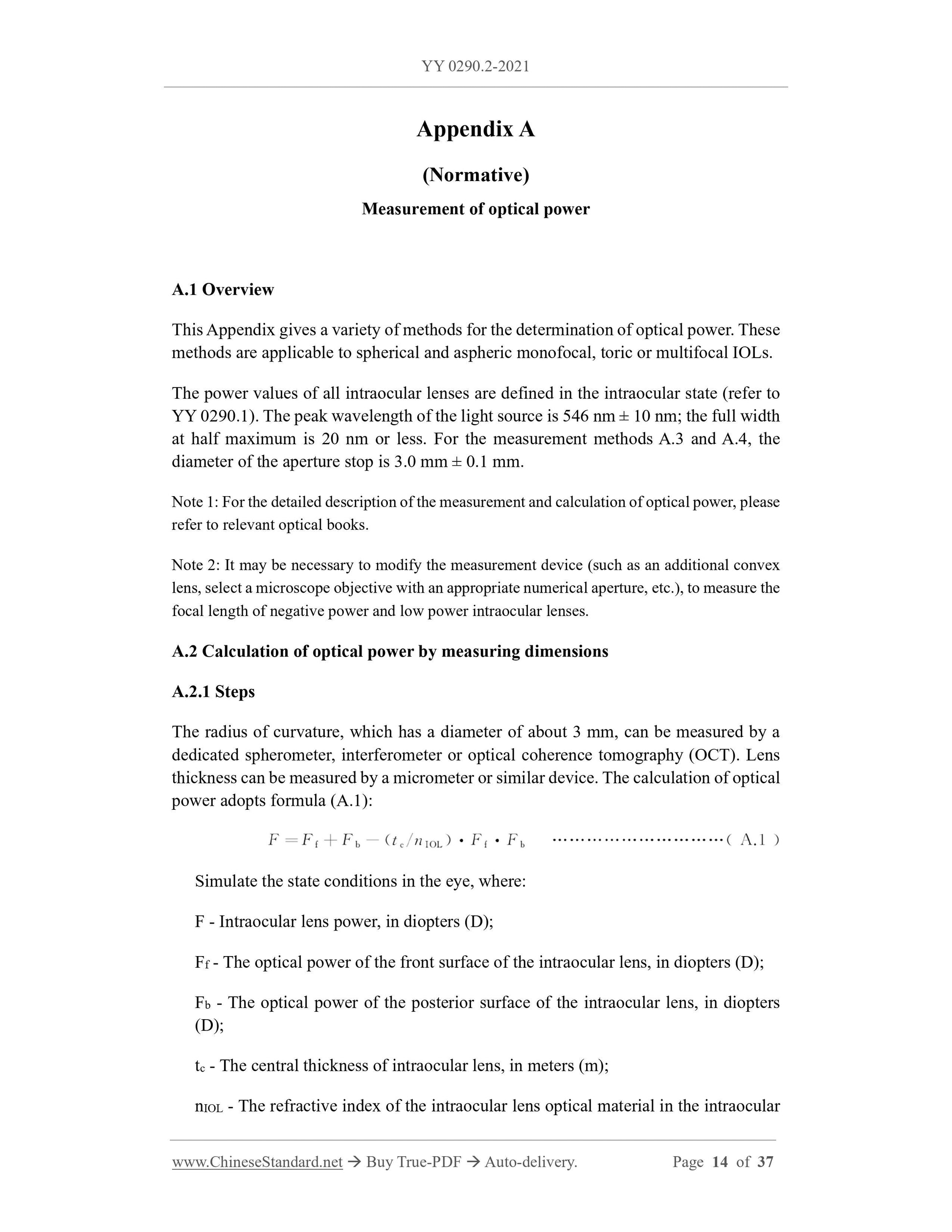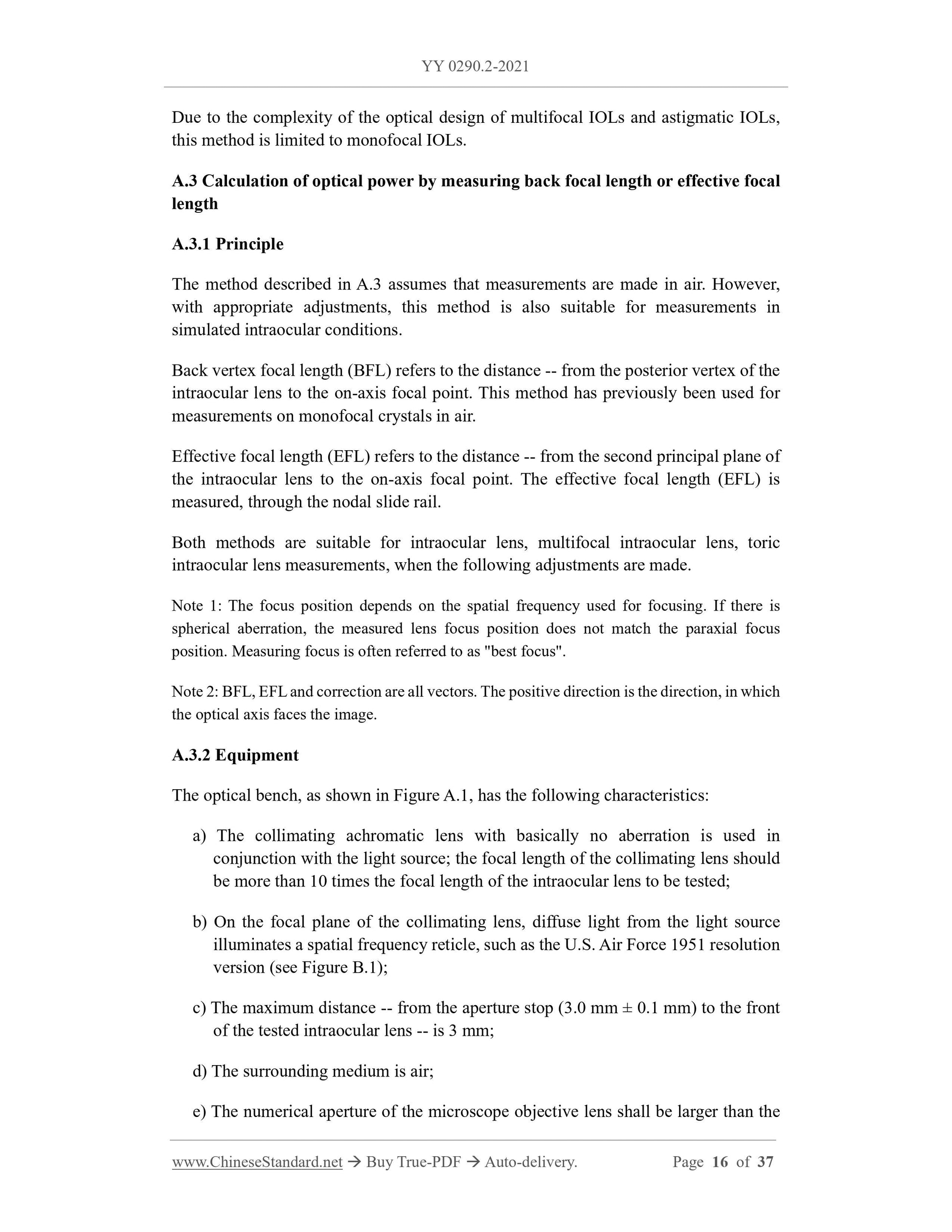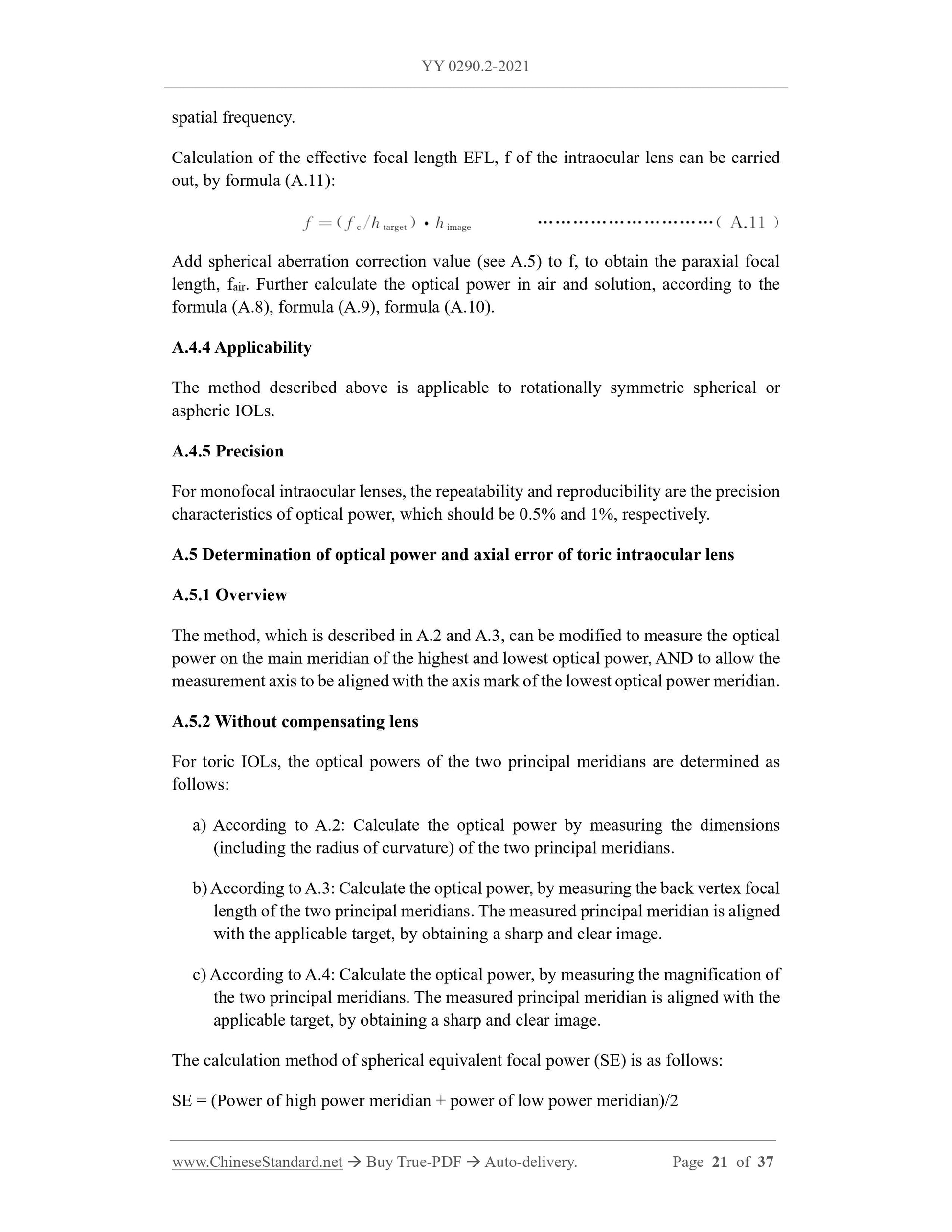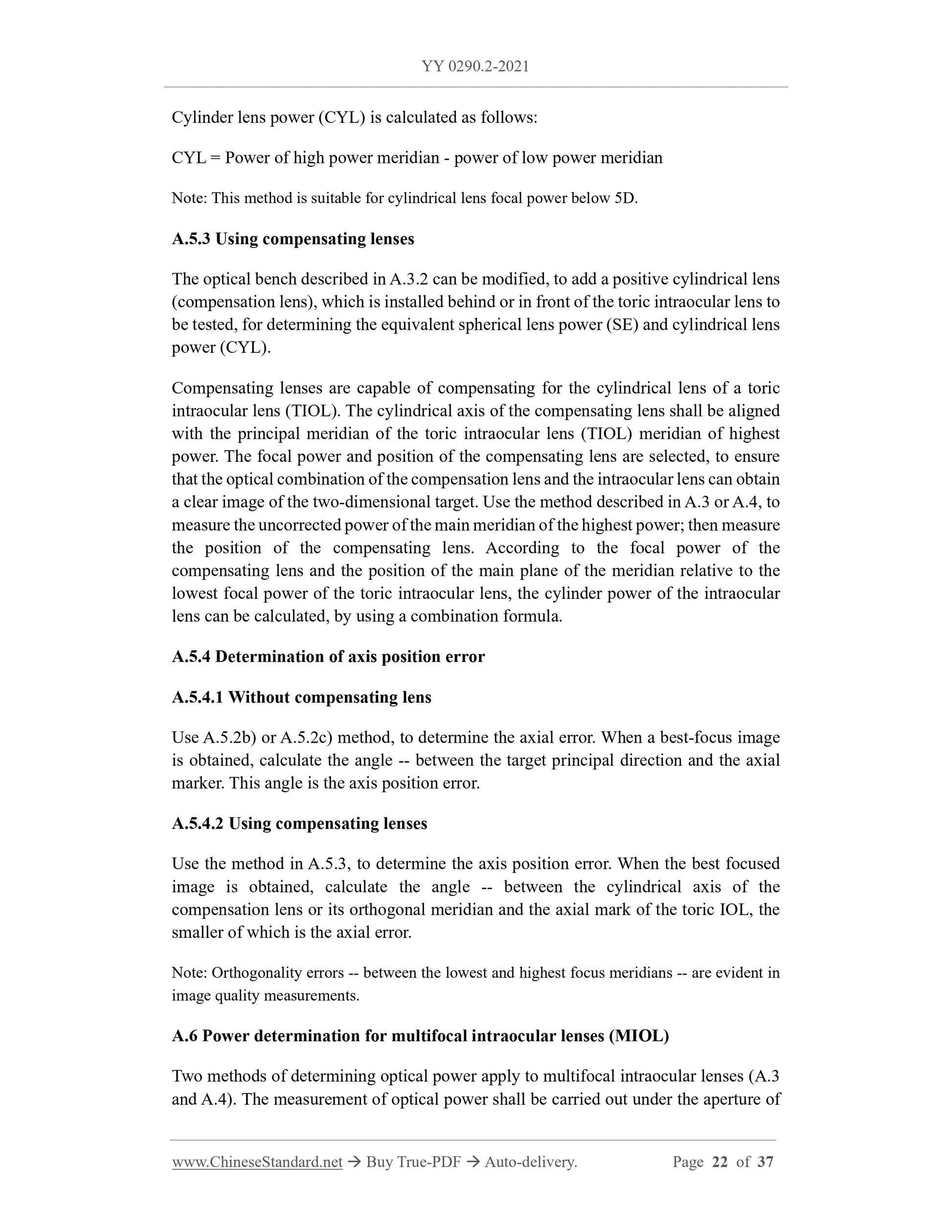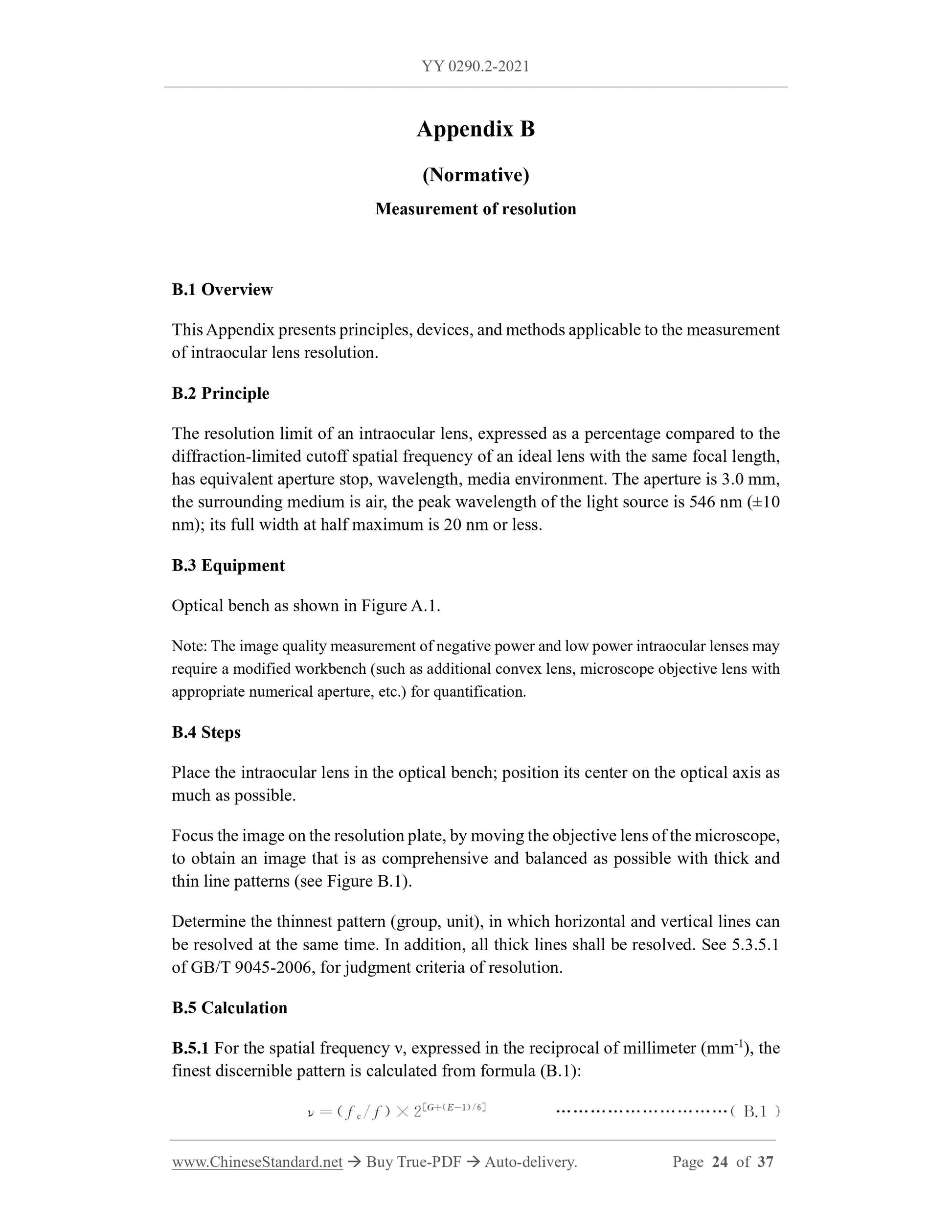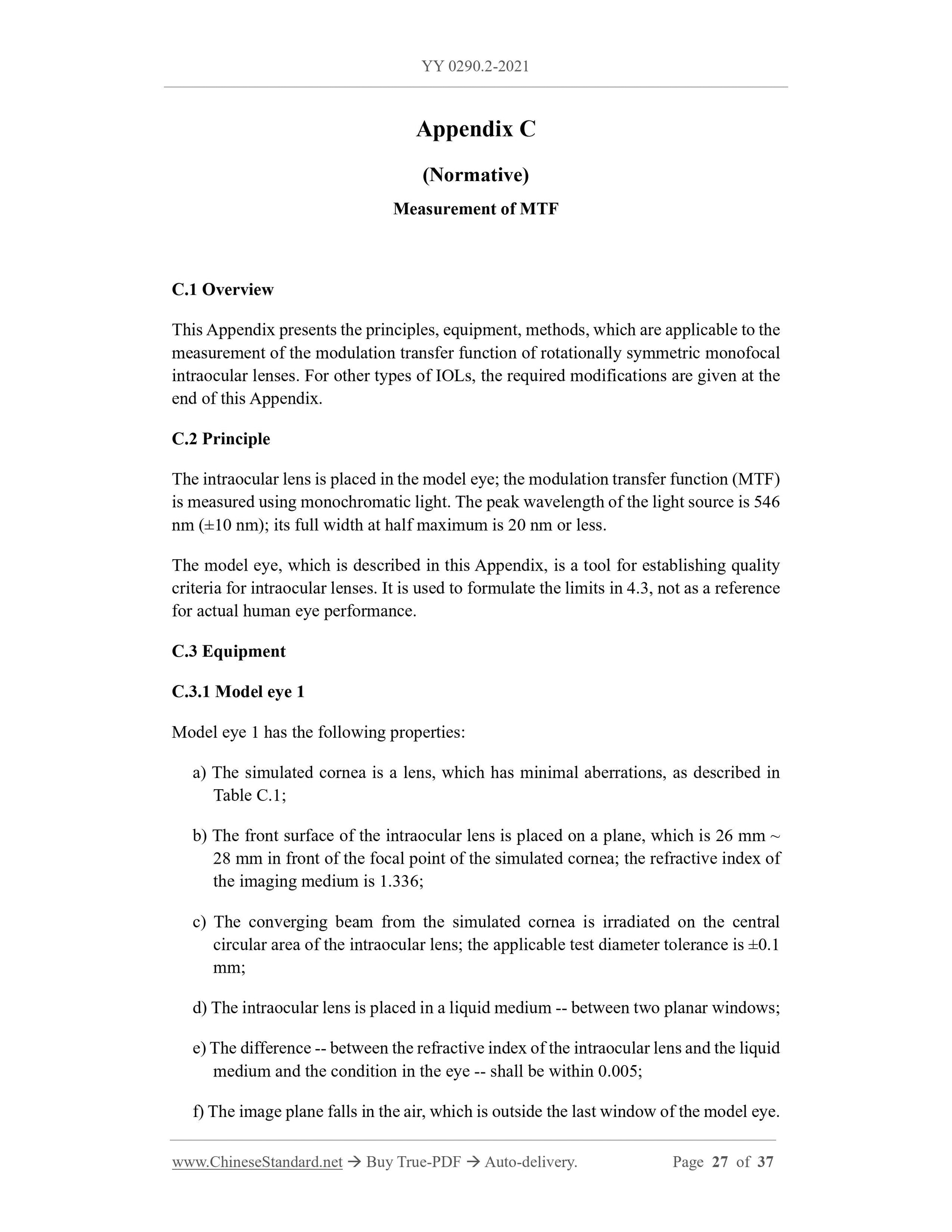1
/
von
12
PayPal, credit cards. Download editable-PDF & invoice in 1 second!
YY 0290.2-2021 English PDF (YY0290.2-2021)
YY 0290.2-2021 English PDF (YY0290.2-2021)
Normaler Preis
$410.00 USD
Normaler Preis
Verkaufspreis
$410.00 USD
Grundpreis
/
pro
Versand wird beim Checkout berechnet
Verfügbarkeit für Abholungen konnte nicht geladen werden
Delivery: 3 seconds. Download true-PDF + Invoice.
Get QUOTATION in 1-minute: Click YY 0290.2-2021
Historical versions: YY 0290.2-2021
Preview True-PDF (Reload/Scroll if blank)
YY 0290.2-2021: Ophthalmic optics -- Intraocular lenses -- Part 2: Optical properties and test methods
YY 0290.2-2021
YY
PHARMACEUTICAL INDUSTRY STANDARD
OF THE PEOPLE’S REPUBLIC OF CHINA
ICS 11.040
C 40
Replacing YY 0290.2-2009
Ophthalmic optics - Intraocular lenses - Part 2: Optical
properties and test methods
(ISO 11979-2:2014, MOD)
ISSUED ON: MARCH 09, 2021
IMPLEMENTED ON: APRIL 01, 2023
Issued by: National Medical Products Administration
Table of Contents
Foreword ... 3
Introduction ... 6
1 Scope ... 7
2 Normative references ... 7
3 Terms and definitions ... 7
4 Requirements ... 8
Appendix A (Normative) Measurement of optical power ... 14
Appendix B (Normative) Measurement of resolution ... 24
Appendix C (Normative) Measurement of MTF ... 27
Appendix D (Informative) Precision of optical power measurements ... 34
Appendix E (Informative) Precision of image quality measurement ... 35
Appendix F (Informative) Verification of ray tracing calculations ... 36
References ... 37
Ophthalmic optics - Intraocular lenses - Part 2: Optical
properties and test methods
1 Scope
This Part specifies the main optical performance requirements and test methods of
intraocular lenses (IOLs).
This Part applies to spherical, aspheric, monofocal, toric, multifocal and/or
accommodating intraocular lenses, which are implanted in the anterior segment of the
human eye. The generic character "intraocular lens (IOLs)" used in this Part also
includes phakic intraocular lens (PIOL).
2 Normative references
The following documents are essential to the application of this document. For the dated
documents, only the versions with the dates indicated are applicable to this document;
for the undated documents, only the latest version (including all the amendments) is
applicable to this standard.
GB/T 4315.1 Optical transfer function - Part 1: Terminology and symbol (GB/T
4315.1-2009, ISO 9334:2007, MOD)
GB/T 4315.2 Optical transfer function - Part 2: Directives of measurement (GB/T
4315.2-2009, ISO 9335:1995, MOD)
GB/T 9045-2006 Photography - Photographic materials - Determination of ISO
resolving power (ISO 6328:2000, IDT)
YY 0290.1 Ophthalmic implants - Intraocular lenses - Part 1: Terminology (YY
0290.1-2008, ISO 11979-1:2006, MOD)
YY 0290.3 Ophthalmic implants - Intraocular lenses - Part 3: Mechanical properties
and test methods (YY 0290.3-2018, ISO 11979-3:2012, MOD)
YY 0290.4 Ophthalmic implants - Intraocular lenses - Part 4: Labeling and
information (YY 0290.4-2008, ISO 11979-4:2000, IDT)
3 Terms and definitions
The terms and definitions, which are defined in YY 0290.1 and GB/T 4315.1, apply to
4.3.1 Overview
Image quality depends on the match between the optical design of the IOL and the
optical performance evaluation conditions. Image quality can be expressed by
resolution or modulation transfer function (MTF) value, under specified spatial
frequency conditions. Perform the resolution test, according to the method specified in
Appendix B. Perform the modulation transfer function (MTF) test, according to the
method specified in Appendix C.
The modulation transfer function (MTF), which is determined by the method described
in Appendix C, is related to the matching -- between the optical design and the model
eye suitable for optical performance evaluation. For the method described in Appendix
C, example model eye parameters have been given. The manufacturer may also propose
an equivalent method or model eye suitable for the intended use and design optical
properties. In such cases, the model eye and method shall be adequately described,
along with justification for its applicability. Unless otherwise specified, image quality
requirements apply to all available optical powers.
If, due to theoretical limitations, negative and low power intraocular lenses, which has
the simulated eye described in Appendix C, do not apply to the requirements specified
in 4.3.2 ~ 4.3.6, the manufacturer shall verify the applicable spatial frequency and
requirements.
If the image quality of a specially designed intraocular lens for a special purpose is not
applicable to the requirements specified in 4.3.2 ~ 4.3.6, the manufacturer shall set and
verify the applicable spatial frequency and requirements.
Note 1: The optical resolution is expressed in terms of spatial frequency. The unit is usually line
logarithm/mm (lp/mm) or cycle/mm (c/mm or mm-1). In ophthalmology literature, the
commonly used unit is cycle/degree (c/degree). For the eyes, the image square node distance is
considered to be 17 mm; the conversion formula between the two is as follows:
c/degree = 0.297 × c/mm
Note 2: The test aperture, which is provided in 4.3 and Appendix A, Appendix B, Appendix C,
indicates the central area of the test intraocular lens exposure, which is different from the
aperture stop of the test system.
4.3.2 Monofocal intraocular lenses
4.3.2.1 Overview
The image quality of monofocal intraocular lenses shall meet any of the requirements
specified in 4.3.2.2, 4.3.2.3 or 4.3.2.4.
4.3.2.2 Resolution
If tested according to the method in Appendix B, the resolution of the intraocular lens
shall not be less than 60% of the diffraction-limited cut-off spatial frequency, under the
3 mm aperture. In addition, the image shall be free of detectable aberrations other than
spherical aberration.
4.3.2.3 MTF measurement using model eye 1
If tested according to the method of model eye system 1 (C.3.1) in Appendix C, the
modulation transfer function (MTF) value of the intraocular lens, in the model eye
system, shall meet one of the following two conditions, at a spatial frequency of 100
mm-1:
a) Greater than or equal to 0.43;
b) Greater than or equal to 70% of the calculated maximum attainable value, which
is given by the design and analysis of the intraocular lens in the model eye system;
however in any case, it shall not be less than 0.28.
Note: For PMMA intraocular lenses within the range of 10D ~ 30D, the evaluation criteria given
in 4.3.2.2 and 4.3.2.3a) have good consistency.
4.3.2.4 MTF measurement using model eye 2
If tested according to the method of model eye system 2 (C.3.2) in Appendix C, the
modulation transfer function (MTF) value of the intraocular lens, in the model eye
system, shall meet the requirement that the intraocular lens, under the aperture of
greater than or equal to 3 mm, at the spatial frequency of 100 mm-1, reaches 70% of the
calculated maximum achievable value given in the design and analysis of model eye
system; however, in any case, it shall not be less than 0.28.
4.3.3 Toric intraocular lens (TIOL)
4.3.3.1 Overview
The image quality of the toric intraocular lens shall meet the requirements, which are
specified in 4.3.3.2 or 4.3.3.3.
4.3.3.2 Resolution
When using the compensating lens method in Appendix B, the resolution requirements
specified in 4.3.2.2 shall apply to the combined system of toric intraocular lens and
compensating lens.
4.3.3.3 MTF
The MTF requirements, which are specified in 4.3.2.3 or 4.3.2.4, shall apply to the
meridian of highest and lowest optical power.
Use a spectrophotometer, to measure and record the spectral transmittance of the
intraocular lens in the test solution, in the range of 300 nm ~ 1100 nm with an aperture
of 3 mm. If it is measured in air, it can be corrected, according to the principle of
specular reflection. The transmittance accuracy shall be better than ±2%; the resolution
shall not be less than 5 nm. The sample shall be an actual IOL o...
Get QUOTATION in 1-minute: Click YY 0290.2-2021
Historical versions: YY 0290.2-2021
Preview True-PDF (Reload/Scroll if blank)
YY 0290.2-2021: Ophthalmic optics -- Intraocular lenses -- Part 2: Optical properties and test methods
YY 0290.2-2021
YY
PHARMACEUTICAL INDUSTRY STANDARD
OF THE PEOPLE’S REPUBLIC OF CHINA
ICS 11.040
C 40
Replacing YY 0290.2-2009
Ophthalmic optics - Intraocular lenses - Part 2: Optical
properties and test methods
(ISO 11979-2:2014, MOD)
ISSUED ON: MARCH 09, 2021
IMPLEMENTED ON: APRIL 01, 2023
Issued by: National Medical Products Administration
Table of Contents
Foreword ... 3
Introduction ... 6
1 Scope ... 7
2 Normative references ... 7
3 Terms and definitions ... 7
4 Requirements ... 8
Appendix A (Normative) Measurement of optical power ... 14
Appendix B (Normative) Measurement of resolution ... 24
Appendix C (Normative) Measurement of MTF ... 27
Appendix D (Informative) Precision of optical power measurements ... 34
Appendix E (Informative) Precision of image quality measurement ... 35
Appendix F (Informative) Verification of ray tracing calculations ... 36
References ... 37
Ophthalmic optics - Intraocular lenses - Part 2: Optical
properties and test methods
1 Scope
This Part specifies the main optical performance requirements and test methods of
intraocular lenses (IOLs).
This Part applies to spherical, aspheric, monofocal, toric, multifocal and/or
accommodating intraocular lenses, which are implanted in the anterior segment of the
human eye. The generic character "intraocular lens (IOLs)" used in this Part also
includes phakic intraocular lens (PIOL).
2 Normative references
The following documents are essential to the application of this document. For the dated
documents, only the versions with the dates indicated are applicable to this document;
for the undated documents, only the latest version (including all the amendments) is
applicable to this standard.
GB/T 4315.1 Optical transfer function - Part 1: Terminology and symbol (GB/T
4315.1-2009, ISO 9334:2007, MOD)
GB/T 4315.2 Optical transfer function - Part 2: Directives of measurement (GB/T
4315.2-2009, ISO 9335:1995, MOD)
GB/T 9045-2006 Photography - Photographic materials - Determination of ISO
resolving power (ISO 6328:2000, IDT)
YY 0290.1 Ophthalmic implants - Intraocular lenses - Part 1: Terminology (YY
0290.1-2008, ISO 11979-1:2006, MOD)
YY 0290.3 Ophthalmic implants - Intraocular lenses - Part 3: Mechanical properties
and test methods (YY 0290.3-2018, ISO 11979-3:2012, MOD)
YY 0290.4 Ophthalmic implants - Intraocular lenses - Part 4: Labeling and
information (YY 0290.4-2008, ISO 11979-4:2000, IDT)
3 Terms and definitions
The terms and definitions, which are defined in YY 0290.1 and GB/T 4315.1, apply to
4.3.1 Overview
Image quality depends on the match between the optical design of the IOL and the
optical performance evaluation conditions. Image quality can be expressed by
resolution or modulation transfer function (MTF) value, under specified spatial
frequency conditions. Perform the resolution test, according to the method specified in
Appendix B. Perform the modulation transfer function (MTF) test, according to the
method specified in Appendix C.
The modulation transfer function (MTF), which is determined by the method described
in Appendix C, is related to the matching -- between the optical design and the model
eye suitable for optical performance evaluation. For the method described in Appendix
C, example model eye parameters have been given. The manufacturer may also propose
an equivalent method or model eye suitable for the intended use and design optical
properties. In such cases, the model eye and method shall be adequately described,
along with justification for its applicability. Unless otherwise specified, image quality
requirements apply to all available optical powers.
If, due to theoretical limitations, negative and low power intraocular lenses, which has
the simulated eye described in Appendix C, do not apply to the requirements specified
in 4.3.2 ~ 4.3.6, the manufacturer shall verify the applicable spatial frequency and
requirements.
If the image quality of a specially designed intraocular lens for a special purpose is not
applicable to the requirements specified in 4.3.2 ~ 4.3.6, the manufacturer shall set and
verify the applicable spatial frequency and requirements.
Note 1: The optical resolution is expressed in terms of spatial frequency. The unit is usually line
logarithm/mm (lp/mm) or cycle/mm (c/mm or mm-1). In ophthalmology literature, the
commonly used unit is cycle/degree (c/degree). For the eyes, the image square node distance is
considered to be 17 mm; the conversion formula between the two is as follows:
c/degree = 0.297 × c/mm
Note 2: The test aperture, which is provided in 4.3 and Appendix A, Appendix B, Appendix C,
indicates the central area of the test intraocular lens exposure, which is different from the
aperture stop of the test system.
4.3.2 Monofocal intraocular lenses
4.3.2.1 Overview
The image quality of monofocal intraocular lenses shall meet any of the requirements
specified in 4.3.2.2, 4.3.2.3 or 4.3.2.4.
4.3.2.2 Resolution
If tested according to the method in Appendix B, the resolution of the intraocular lens
shall not be less than 60% of the diffraction-limited cut-off spatial frequency, under the
3 mm aperture. In addition, the image shall be free of detectable aberrations other than
spherical aberration.
4.3.2.3 MTF measurement using model eye 1
If tested according to the method of model eye system 1 (C.3.1) in Appendix C, the
modulation transfer function (MTF) value of the intraocular lens, in the model eye
system, shall meet one of the following two conditions, at a spatial frequency of 100
mm-1:
a) Greater than or equal to 0.43;
b) Greater than or equal to 70% of the calculated maximum attainable value, which
is given by the design and analysis of the intraocular lens in the model eye system;
however in any case, it shall not be less than 0.28.
Note: For PMMA intraocular lenses within the range of 10D ~ 30D, the evaluation criteria given
in 4.3.2.2 and 4.3.2.3a) have good consistency.
4.3.2.4 MTF measurement using model eye 2
If tested according to the method of model eye system 2 (C.3.2) in Appendix C, the
modulation transfer function (MTF) value of the intraocular lens, in the model eye
system, shall meet the requirement that the intraocular lens, under the aperture of
greater than or equal to 3 mm, at the spatial frequency of 100 mm-1, reaches 70% of the
calculated maximum achievable value given in the design and analysis of model eye
system; however, in any case, it shall not be less than 0.28.
4.3.3 Toric intraocular lens (TIOL)
4.3.3.1 Overview
The image quality of the toric intraocular lens shall meet the requirements, which are
specified in 4.3.3.2 or 4.3.3.3.
4.3.3.2 Resolution
When using the compensating lens method in Appendix B, the resolution requirements
specified in 4.3.2.2 shall apply to the combined system of toric intraocular lens and
compensating lens.
4.3.3.3 MTF
The MTF requirements, which are specified in 4.3.2.3 or 4.3.2.4, shall apply to the
meridian of highest and lowest optical power.
Use a spectrophotometer, to measure and record the spectral transmittance of the
intraocular lens in the test solution, in the range of 300 nm ~ 1100 nm with an aperture
of 3 mm. If it is measured in air, it can be corrected, according to the principle of
specular reflection. The transmittance accuracy shall be better than ±2%; the resolution
shall not be less than 5 nm. The sample shall be an actual IOL o...
Share
